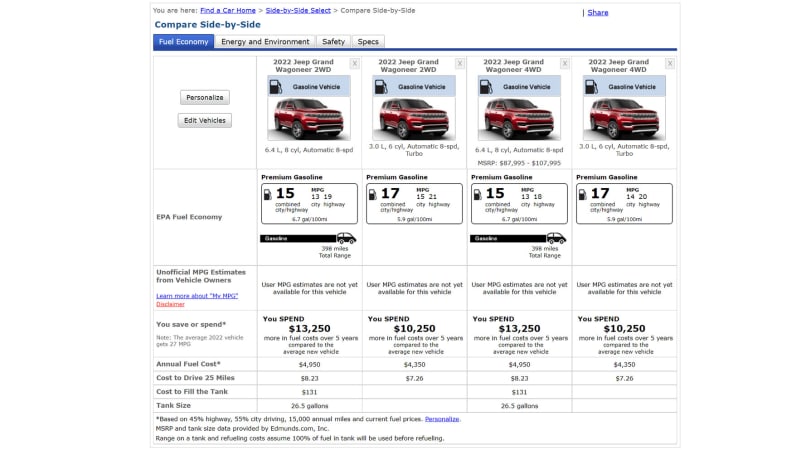The standard-wheelbase 2022 Jeep Grand Wagoneer with the 3.0-liter Hurricane inline-six has its first set of official fuel economy numbers from the EPA. These fuel economy figures apply to the high-output variant, which makes 510 horsepower and 500 pound-feet of torque (to the eight-cylinder’s 471 hp and 455 lb-ft). The rear-wheel drive Wagoneer’s “Hurricane 510” gets 15 miles per gallon in the city, 21 on the highway, and 17 combined, each of those numbers beating the 6.4 by two miles per gallon. When turning both axles, the Hurricane returns 14 mpg in the city, 20 mpg on the highway, and 17 mpg combined. The city figure bests the V8 by one mile per gallon; the highway and combined figures are two miles per gallon better.
No, the Hurricane isn’t going to blow anyone away with its frugality, and that’s before real-world driving; the six-cylinder wouldn’t be downsized engine to see its EPA numbers take a hit in daily use, if that happens. The EPA assumes a savings of $600 per year in fuel costs for the six-cylinder for those who drive the Jeep 15,000 miles per year. The EPA doesn’t factor the $2,000 extra cost to option the inline-six, though. For now, the slight gains come with sizeable gains in power and torque, which will be felt when getting the Wagoneer moving.
Next year, Jeep will slot the standard-output Hurricane into the Wagoneer and Grand Wagonner lineups. That engine makes 420 hp and 450 lb-ft., and has been tuned specifically for fuel economy. It will be put up against the 5.7-liter V8 making 392 hp and 404 lb-ft., but it should be noted that the high-output inline-six in the rear-wheel drive Grand Wagoneer only loses one mile per gallon to the 5.7-liter V8 in the smaller rear-wheel drive Wagoneer, and loses just one mile per gallon in the city to the 5.7-liter V8 in the smaller SUV in AWD trim. The standard-output Hurricane should make a decent showing.
Related Video
Source: www.autoblog.com

